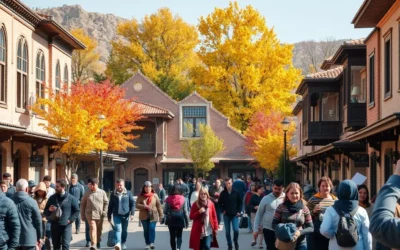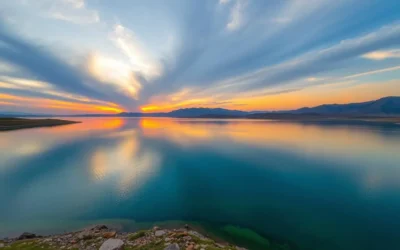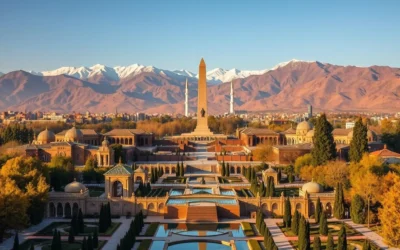✓ Accommodations✓ Flights✓ Rental Cars
Welcome to a city where history and culture come alive. Known as the cultural heart of Iran, this destination boasts over 4,000 years of rich heritage. From ancient landmarks to modern-day vibrancy, it’s a place where every corner tells a story.
Here, you’ll find a blend of UNESCO World Heritage Sites, literary legends, and stunning architecture from the Zand dynasty era. The city is home to four UNESCO sites, including the majestic Persepolis and the serene Eram Garden.
Whether you’re exploring historical sites or savoring unique culinary delights, there’s something for everyone. Plan your trip to uncover hidden gems and immerse yourself in the local lifestyle. With so much to see and do, you’ll want to spend at least three days here to fully experience it all.
Ready to dive into this captivating world? Let’s explore the top attractions and experiences that make this city a must-visit destination.
Introduction to the Cultural Heart of Shiraz
Discover a place where culture and creativity intertwine effortlessly. This city has long been celebrated as the cultural capital of Iran, a title earned through its rich history and artistic contributions. From ancient dynasties to modern-day artisans, it’s a destination that continues to inspire.
Discover the Rich History and Artistic Heritage
With a history spanning over 4,000 years, this city has been a hub for poets, artists, and thinkers. Its streets are lined with stories of legendary figures like Hafez and Saadi, whose works have left an indelible mark on Persian literature. The vibrant art scene here is a testament to its enduring legacy.
One of the most unique aspects of this city is its blend of tradition and modernity. While ancient landmarks stand tall, contemporary art galleries and workshops thrive, showcasing the creativity of its people. Glass art, in particular, plays a significant role in local architecture, adding a touch of elegance to its structures.
What Makes Shiraz a Must-Visit Destination
No visit is complete without exploring the bustling bazaars, where you can experience the pulse of local life. These markets are not just places to shop but also cultural hubs where artisans display their crafts, from intricate rugs to handmade jewelry.
Here’s what makes this city truly special:
- Its deep connection to poetry and literature.
- The vibrant art scene that bridges past and present.
- The lively bazaars that offer a glimpse into everyday life.
- The craftsmanship seen in glass art and architecture.
Whether you’re spending a day or a week, this city promises an unforgettable journey through time and culture. Its unique charm lies in its ability to preserve its heritage while embracing the present, making it a must-visit for any traveler.
Historical Significance and Architectural Marvels
Step into a world where ancient history meets architectural brilliance. This city has been a cultural hub for over 4,000 years, with each century leaving its mark on its skyline. From its early origins to the transformative Zand dynasty, the evolution of its architecture is a testament to its enduring legacy.
The Evolution from Ancient Eras to the Zand Dynasty
The story of this city begins around 2000 BC, with successive dynasties shaping its identity. The Zand dynasty, under the leadership of Karim Khan Zand, brought significant changes. During this time, the city became a center of art, culture, and governance. Karim Khan’s vision led to the construction of iconic structures that still stand today.
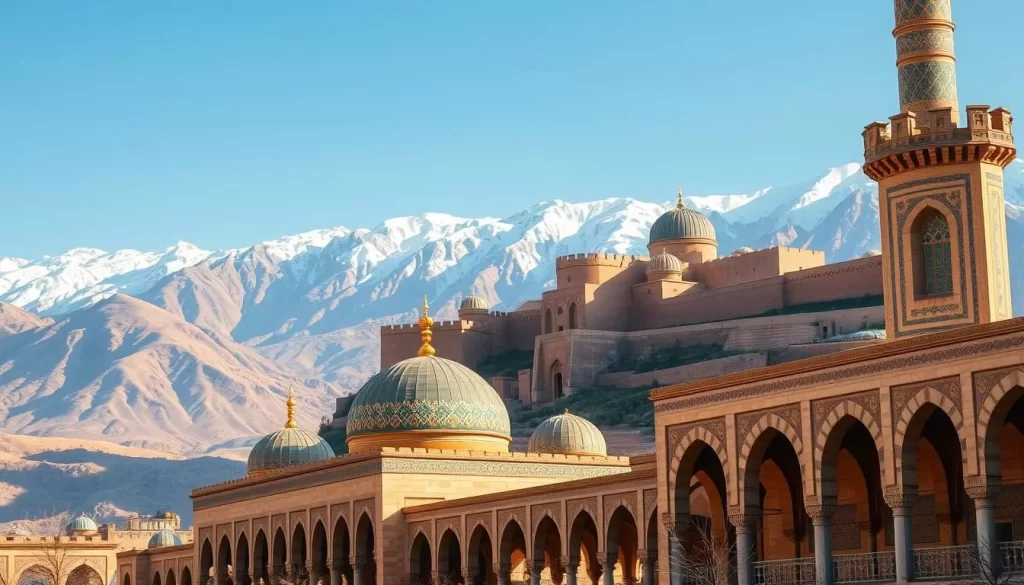
Notable Landmarks and UNESCO Heritage Sites
This city is home to several UNESCO World Heritage sites, each a masterpiece of architecture. Persepolis, built by Darius I around 518 BC, is a must-visit attraction. Its grandeur reflects the power of the Achaemenid Empire. Another gem is the Eram Garden, a serene oasis that showcases Persian garden design at its finest.
Here’s a quick guide to some of the most iconic landmarks:
| Landmark | Historical Period | Significance |
|---|---|---|
| Persepolis | Achaemenid Empire | Ceremonial capital of the empire |
| Eram Garden | Zand Dynasty | Exemplifies Persian garden design |
| Vakil Complex | Zand Dynasty | Includes bazaar, mosque, and bathhouse |
As a tourist, you’ll find that walking through these sites is like stepping back in time. Each structure tells a story, offering a unique way to connect with the past. Whether you’re an architecture enthusiast or a history buff, these landmarks are sure to leave a lasting impression.
Experiencing the Pink Mosque – Nasir al Molk’s Morning Glory
Immerse yourself in a world of color and light at the Nasir al Molk Mosque. Known as the Pink Mosque, this architectural gem is a masterpiece of Qajar design. Built between 1876 and 1888, it’s a testament to the artistry of its time.
Admiring the Stained Glass Windows at Sunrise
The highlight of this mosque is its stunning stained glass windows. As the morning sun rises, the light streams through, creating a kaleidoscope of colors that dance across the floor and walls. It’s a visual experience unlike any other, transforming the space into a magical world of hues.
For the best effect, visit during the early morning hours. The interplay of light and color is most vibrant at this time, making it a photographer’s dream. Don’t forget to look up—the intricate patterns on the ceiling are equally mesmerizing.
Practical Visitor Tips and Entrance Details
Planning your visit is easy. The entrance fee is affordable, and the mosque is accessible to all. Here are some tips to make the most of your trip:
- Arrive early to avoid crowds and enjoy the morning light.
- Dress modestly, as this is a place of worship.
- Bring a camera to capture the stunning visuals.
This attraction is a must-see for anyone visiting the city. Its unique blend of architecture and artistry makes it a highlight of any trip. Whether you’re a history buff or simply seeking beauty, the Pink Mosque promises an unforgettable experience.
Exploring the Vakil Complex: Markets and Mosques
Experience the vibrant energy of the Vakil Complex, a cornerstone of cultural and architectural heritage. Built during the Zand dynasty, this complex encapsulates the brilliance of its era, blending history, commerce, and artistry into one captivating destination.
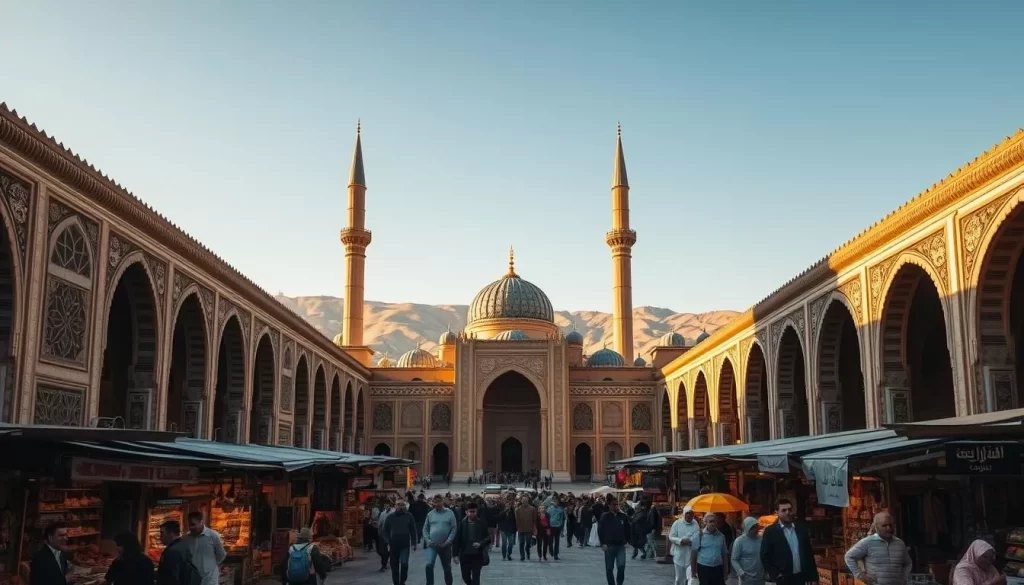
Wandering through the Vakil Bazaar
Step into the historic Vakil Bazaar, a bustling marketplace that has been the heart of the city for centuries. Here, you’ll find a treasure trove of artisanal crafts, from intricate rugs to handmade jewelry. Don’t forget to haggle—it’s part of the experience!
Spend a day exploring the narrow alleys, where the scent of spices and the chatter of vendors create an unforgettable atmosphere. This is a must-see for any tourist looking to immerse themselves in local culture.
Discovering the Charm of Vakil Mosque and Hammam e Vakil
Adjacent to the bazaar lies the Vakil Mosque, a masterpiece of Zand dynasty architecture. With its 48 pillars and expansive courtyard, it’s a serene escape from the bustling market. Nearby, the Hammam e Vakil, once a traditional bathhouse, now serves as a museum, offering a glimpse into daily life during Karim Khan’s time.
Here’s a quick guide to the Vakil Complex:
| Attraction | Highlights |
|---|---|
| Vakil Bazaar | Artisanal crafts, spices, and local goods |
| Vakil Mosque | 48 pillars, serene courtyard |
| Hammam e Vakil | Traditional bathhouse turned museum |
The Vakil Complex is more than just a collection of landmarks—it’s a journey through time, capturing the commercial and cultural spirit of the region. Whether you’re exploring the bazaar or marveling at the mosque, this complex promises an unforgettable experience.
Treasures of Persian Gardens and Cultural Oases
Step into a serene escape where nature and art intertwine in perfect harmony. The Persian gardens are a testament to centuries-old landscape design, blending lush greenery with intricate water features. These gardens are not just attractions but cultural symbols that reflect the harmony between humans and nature.
Strolling through Eram Garden’s Natural Beauty
Eram Garden is a masterpiece of Persian garden design. With its towering cypress trees, vibrant floral arrangements, and reflective pools, it’s a place of tranquility. The garden’s layout, based on the four sacred elements of water, wind, fire, and soil, creates a balanced and serene atmosphere.
Spend a day wandering through its pathways, where every corner reveals a new layer of beauty. The sound of flowing water and the scent of blooming flowers make it a sensory delight. It’s a must-visit for anyone seeking peace amidst nature’s splendor.
Uncovering the Elegance of Narenjestan Garden
Narenjestan Garden is another gem, known for its orange blossoms and ancient architecture. Built during the Qajar era, it’s a symbol of elegance and sophistication. The garden’s design, with its symmetrical layout and ornate pavilions, showcases the artistry of its time.
As you explore, you’ll notice how the garden seamlessly blends natural beauty with architectural brilliance. It’s a world where every detail tells a story, making it a perfect spot for history and nature lovers alike.
Here are some tips to enhance your visit:
- Visit early in the morning to enjoy the gardens in their most peaceful state.
- Take your time to appreciate the intricate details of the water features and floral arrangements.
- Capture the beauty with your camera, but don’t forget to soak in the moment.
These gardens are more than just green spaces—they are a reflection of culture and history. Whether you’re exploring Eram Garden or Narenjestan, you’ll leave with a deeper appreciation for the artistry and tranquility they offer.
Literary Legacy: Tombs of Hafez and Saadi
Explore the timeless allure of literary legends in serene gardens. The resting places of Hafez and Saadi are more than just tombs—they are cultural landmarks that celebrate the profound impact of Persian poetry. These sites invite you to step into a world where words and history intertwine.
Paying Homage at the Tomb of Hafez
The Tomb of Hafez is a pilgrimage site for lovers of poetry. Nestled in a peaceful garden, it’s a place where visitors recite verses and seek inspiration. The tomb itself is a masterpiece of stonework and glass, reflecting the elegance of its design.
Visit during sunset for a reflective experience. The soft light enhances the beauty of the garden, creating a tranquil atmosphere. Don’t forget to bring a guide to fully appreciate the historical and literary significance of this site.
Experiencing Saadi’s Garden and Shrine
Saadi’s shrine is another gem, surrounded by lush greenery and water features. Known as the City of Poetry, this site honors one of Persia’s greatest poets. The garden’s design, influenced by Karim Khan’s era, blends natural beauty with architectural brilliance.
Take your time to wander through the pathways, where every corner tells a story. The harmonious blend of stone, glass, and greenery makes it a must-visit for anyone interested in history and culture.
Here are some tips for your visit:
- Arrive in the late afternoon to enjoy the gardens in their most peaceful state.
- Dress modestly, as these are places of cultural and spiritual significance.
- Engage with locals to learn more about the poets and their enduring legacy.
These sites are not just memorials—they are living testaments to the power of poetry. Whether you’re a literature enthusiast or simply seeking tranquility, the tombs of Hafez and Saadi promise an unforgettable experience.
Spiritual Journeys: The Majestic Shah Cheragh Shrine
Embark on a spiritual journey at the Shah Cheragh Shrine, a beacon of cultural and religious significance. This shrine is not just a place of worship but an architectural masterpiece that captivates visitors with its intricate mirror mosaics and serene ambiance.
Marveling at Intricate Mirror Mosaics
The shrine is renowned for its dazzling mirror mosaics, which create a mesmerizing interplay of light. Every inch of the interior is adorned with reflective glass, transforming the space into a radiant hall of beauty. The effect is particularly striking during the day, when sunlight streams through the stained glass windows, casting colorful patterns across the walls.
Tips on Dress Code and Respectful Visits
When visiting the shrine, it’s important to dress modestly and behave respectfully. Women are required to wear a chador, which can be borrowed at the entrance. Men should avoid wearing shorts and sleeveless shirts. Photography is restricted in certain areas, so be mindful of the rules.
Here’s a quick guide to ensure a smooth visit:
| Aspect | Details |
|---|---|
| Dress Code | Modest attire, chador for women |
| Photography | Restricted in certain areas |
| Guided Tours | Available for an enhanced experience |
Take your time to absorb the serene atmosphere and reflect on the culture and history that surround you. For more insights into this site, check out this Shiraz travel guide.
Culinary Delights and Local Flavors in Shiraz
Dive into a culinary journey where flavors tell stories of tradition and culture. The city’s food scene is a vibrant reflection of its rich heritage, offering a mix of savory dishes, refreshing salads, and unique desserts. From aromatic spices to fresh ingredients, every bite is a celebration of Persian cuisine.

Savoring Traditional Shirazi Dishes
Start your day with Kalam Polow, a flavorful dish of rice and cabbage infused with spices like saffron and cinnamon. For a refreshing side, try Shirazi Salad, a mix of cucumbers, tomatoes, and onions with a tangy dressing. Don’t miss Faloodeh, a sweet dessert made with vermicelli noodles and rosewater syrup.
These dishes are not just meals but cultural symbols. For example, Ghormeh Sabzi, a herb stew, is often served during family gatherings, highlighting its communal significance.
Finding the Best Teahouses and Street Food Spots
For an authentic experience, visit local teahouses where you can enjoy black tea paired with crystalized sugar. These spots are social hubs, offering a glimpse into the world of Persian hospitality.
Street food vendors are equally enticing. Try Kabab Koobideh, a grilled minced meat kebab, or Baghali Pokhteh, a spiced fava bean snack. Prices are affordable, making it easy to sample a variety of flavors without breaking the bank.
Whether you’re enjoying a meal at a teahouse or exploring street food, the sensory experience is unforgettable. The aromas, flavors, and visual appeal of plated delights make every meal a highlight of your trip.
Hidden Gems: Offbeat Attractions and Traditional Neighborhoods
Uncover the soul of the city through its hidden corners and artisan traditions. Beyond the well-known sites, there’s a place where everyday charm thrives, offering a genuine glimpse into local life. From bustling markets to quiet neighborhoods, these spots invite you to explore the history and creativity that define the city’s identity.
Exploring Local Markets and Artisan Crafts
Wander through the winding alleys of traditional bazaars, where artisans showcase their work. Here, you’ll find handwoven shoes, intricate jewelry, and other unique crafts that reflect centuries-old traditions. These markets are not just shopping destinations but cultural hubs where you can connect with local persons and learn about their art.
For a deeper dive into the city’s craft heritage, visit workshops where traditional practices like “Khatam-Kari” (geometric patterns) are still alive. These spaces offer a rare opportunity to witness creativity in action and take home one-of-a-kind souvenirs.
Discovering Traditional Neighborhoods
Step into the quieter parts of the city, where narrow streets and historic homes tell stories of the past. These neighborhoods are a guide to the way of life that has shaped the city for generations. Take your day to explore, and you’ll find hidden courtyards, charming teahouses, and local shrines that offer a peaceful escape from the bustling tourist areas.
One such place is the Sangaki bakery, a century-old establishment that continues to serve traditional bread. It’s a reminder of the enduring traditions that make this city so special.
Practical Tips for Exploring Hidden Gems
To make the most of your visit, here are some tips:
- Start early to avoid crowds and enjoy the morning calm.
- Engage with locals to learn about their crafts and traditions.
- Carry cash, as many small shops and artisans may not accept cards.
- Take your time to explore; these areas are best experienced at a relaxed pace.
For a guided experience, consider a Shiraz bazaar walking tour, which offers insights into the city’s vibrant markets and artisan practices. These hidden gems provide a unique way to connect with the history and culture of the city, making your visit truly unforgettable.
Practical Travel Tips for Your Shiraz Adventure
Planning your adventure in this historic city? Here’s how to make the most of your trip. From navigating transportation to finding the perfect place to stay, these tips will ensure a smooth and enjoyable experience.
Navigating Transportation and Local Taxis
Getting around is easy with a variety of options. Public transportation is organized and affordable, making it a great choice for budget travelers. For convenience, consider hiring a taxi or driver for the day, which typically costs between $40 and $60.
Local apps can help you book rides or plan routes efficiently. Always agree on the price before starting your journey to avoid surprises. This way, you can focus on exploring without worrying about logistics.
Where to Stay and How to Budget Your Trip
Accommodation options range from cozy guest houses to luxurious hotels. A 5-star hotel, equivalent to 3-4 stars in the U.S., can cost around $30 per night. For a more authentic experience, consider staying in a traditional complex or local homestay.
Budgeting is key to a stress-free trip. Meals can cost as little as $2 for basic options, while a quality restaurant meal averages $10. Plan your time wisely to maximize each hour of your visit.
For a deeper dive into planning, check out this two-week travel guide. It offers additional insights into making the most of your journey while embracing the local culture.

Seasonal Highlights and the Best Time to Visit Shiraz
Timing your visit can make all the difference in experiencing this vibrant destination. Each season brings its own charm, offering unique opportunities to explore the city’s natural beauty and cultural heritage. Whether you’re drawn to blooming gardens or cooler exploration times, planning your trip around the seasons ensures a memorable experience.
Understanding Shiraz’s Climate and Timing Your Visit
Spring, particularly April and May, is the ideal time to visit. The weather is pleasant, with temperatures ranging from 18°C to 30°C, and occasional showers enhance the fragrance of blooming gardens. This is also the peak travel season, so booking accommodations and transportation in advance is recommended.
Summer months (June to August) are hot, with temperatures reaching up to 38°C. However, this is a budget-friendly time to visit, as accommodation and ticket prices drop significantly. Fall (September to November) offers moderate weather, making it perfect for exploring outdoor attractions like gardens and bazaars.
Winter (December to February) is the cheapest time to visit, with average temperatures ranging from 4°C to 14°C. This season is ideal for enjoying indoor attractions and taking advantage of lower travel costs.
Seasonal Attractions and Festivals
Spring is the best time to witness the city’s gardens in full bloom. Eram Garden and Narenjestan Garden are particularly stunning during this season. Spring also hosts cultural events like the National Festival of Persian Horses and the National Music Festival of Traditional and Regional Tunes.
Summer is perfect for exploring indoor attractions like the Pink Mosque and Shah Cheragh Shrine, where the intricate mirror mosaics create a cool, serene atmosphere. Fall is ideal for strolling through traditional neighborhoods and enjoying outdoor dining at local teahouses.
Winter offers a unique opportunity to experience the city’s markets and monuments without the crowds. It’s also a great time to enjoy traditional dishes like Kalam Polow and Shirazi Salad in cozy settings.
Tips for Planning Your Visit
Here’s a quick guide to help you plan your trip:
| Season | Highlights | Tips |
|---|---|---|
| Spring | Blooming gardens, cultural festivals | Book accommodations early |
| Summer | Indoor attractions, budget-friendly | Stay hydrated and dress lightly |
| Fall | Moderate weather, outdoor dining | Explore traditional neighborhoods |
| Winter | Lower travel costs, indoor attractions | Pack warm clothing |
By understanding the seasonal highlights, you can plan your trip to make the most of this city’s beauty and charm. Whether you’re visiting in spring or winter, each season offers a unique way to experience its rich culture and history.
Shiraz, Iran: Best Things to Do – Top Picks
This vibrant destination offers a blend of historical landmarks, artistic heritage, and cultural experiences that make it a must-visit for any traveler. From stunning mosques to serene gardens, every corner of this city tells a story.
Iconic Sites That Define the City’s Heritage
Start your journey at the Nasir al Molk Mosque, known for its breathtaking stained glass windows. Built between 1876 and 1888, this architectural marvel is a testament to the artistry of its time. Next, explore the Vakil Complex, a hub of commerce and culture that includes the historic Vakil Bazaar and Mosque.
For a tranquil escape, visit Eram Garden, a UNESCO World Heritage site renowned for its tall cypress trees and sparkling pools. Don’t miss the tombs of Hafez and Saadi, where you can pay homage to two of Persia’s greatest poets.
Why This City is a Cultural Treasure
This destination is not just about landmarks; it’s about the history and art that shape its identity. The city’s bazaars, like the Vakil Bazaar, are bustling hubs where you can find everything from handmade crafts to traditional spices.
Here’s a quick guide to the top attractions:
| Attraction | Highlights |
|---|---|
| Nasir al Molk Mosque | Stained glass windows, vibrant colors |
| Vakil Complex | Historic bazaar, mosque, and bathhouse |
| Eram Garden | Tall cypress trees, reflective pools |
| Tombs of Hafez and Saadi | Literary heritage, serene gardens |
For more insights into planning your trip, check out this travel guide. Whether you’re exploring for an hour or a full day, this city promises an unforgettable experience.
Conclusion
As your journey through this vibrant destination comes to a close, you’ll find it’s a place where every moment feels like a discovery. From the beauty of its gardens to the warmth of its people, this city is a perfect blend of culture and life. Whether you spend a day exploring its shrines or sipping tea in a traditional house, every hour offers something new.
Use this guide to plan your visit and navigate local customs with ease. The charm of this place lies in its ability to connect you with its history while offering modern comforts. Don’t miss the chance to explore more cultural gems that make this destination unforgettable.
Let the memories of your adventure inspire you to return, knowing there’s always more to discover in this enchanting corner of the world.
The above is subject to change.
Check back often to TRAVEL.COM for the latest travel tips and deals.


